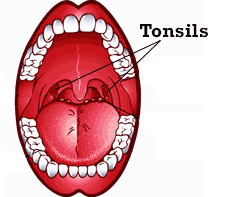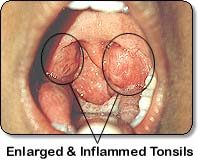The tonsils play a small role in fighting infections in our body but they can be a source of infection and obstruction for both adults and children, and are responsible for a significant number of childhood diseases. An infection of the tonsils is called tonsillitis and it is mostly seen in children and young adults. Serious infection of the tonsils can cause some problems and tonsillectomy may be needed to rectify them.
What is tonsillectomy?
Tonsillectomy is a surgery to remove the tonsils which are located on either side of the back of the throat. Tonsillectomy is needed when the tonsils become infected frequently (tonsillitis). In many cases, tonsillectomy may be a more effective and less costly treatment than extended or repeated treatments for an infected throat. Tonsillectomy in children is one of the more common surgeries performed on children but the surgical procedure is done less often in adults. However tonsillectomy is only considered when other treatment methods are not effective as some tonsillitis cases can be cured without the need for surgery.
When do we need tonsillectomy?
- Recurrent acute tonsillitis, with more than 6 to 7 episodes in a year, 5 episodes per year for 2 years, or 3 episodes per year for 3 years
- Chronic tonsillitis that do not respond to medical treatment
- Peritonsillar abscess (pus formation around the tonsils) with history of infections of the tonsils
- Heroic snoring with chronic mouth breathing
- Obstructive sleep apnea (stopping or obstructing breathing at night due to enlarged tonsils) or sleep disturbances
- Enlarged tonsils with difficulty in swallowing or speech problems
- Enlarged tonsils with abnormal growth of face or biting problems
- Enlarged tonsil in only one side or suspected tumor of the tonsils
What should we expect after a tonsillectomy?
Tonsillectomy has a postoperative course with significant morbidity and potential complications. After surgery, some individuals usually have considerable odynophagia (severe pain in swallowing), a change of diet and decreased activity. The tonsillectomy recovery time for children is usually 4 days to a week while adults may have symptoms for up to 2 weeks.
Pain management after tonsillectomy
Most individuals have a significant amount of pain after tonsillectomy, with adults having more prolonged pain. Lozenges with local numbing action, pain medications or anti-inflammatory drugs will be prescribed to ease the pain but it will eventually resolve 5 to 12 days after surgery. Many children will complain of ear aches (otalgia) after tonsillectomy but take note that the pain coming from throat and not the ears.
During tonsillectomy recovery:
- Antibiotics may be prescribed so remember to take the entire course as instructed.
- Stay hydrated by drinking lots of water but sometimes the odynophagia can be severe enough to limit oral intake and children and adults on occasion may become dehydrated and require hospital admission for fluid drips.
- Food for tonsillectomy – for the first 48 hours, take cold foods to numb the area. After 48 hours, a lukewarm diet should be taken and you must start eating normal diet as early as possible. Hard, hot and spicy food should be avoided for at least 10 days therefore it is advisable to take soft foods to eat after tonsillectomy.
Why is there bad breath after tonsillectomy?
Most area of the tonsils after the surgery are covered with white exudates, fluid that is usually full of bacteria and germs, for up to 12 days. As sometimes the fluid could not be drained away completely, it could lead to bad breath after a tonsillectomy.
Gargling with salt water, or alcohol-free mouthwash, on a regular basis can help rinse away these fluids and to keep you hydrated. Weak hydrogen peroxide gargles may be prescribed by your doctor to help remove any dead tissues that can accumulate bacteria.
Another reason as to why you have bad breath after a tonsillectomy is the change of diet. Soft dairy products such as yogurt and cheese are usually taken but the breakdown of these food particles in your teeth and the digestion of food with volatile oils can cause foul odor.
The bad breath should revert back to normal after the tonsils area has healed and when you start having your normal diet again.
When to see a doctor after tonsillectomy?
- Bleeding: If the surgical area starts to bleed, it is advisable to visit your doctor. Some severe bleeding cases may require a return to the operating room.
- High Fever: Temperatures greater than 102°F (38.9°C), or when accompanied by cough or difficulty breathing, should be reported to your doctor.
- Dehydration: If there has been trouble swallowing with little or no liquids taken for 24 hours, notify your doctor. Signs or symptoms of dehydration include weakness, dry mouth, headache, dizziness, tiredness and reduced urination.



Pingback: How to stop snoring at night naturally ? | Intelligent Dental